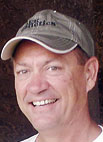
Where can you find a good quality forage that is drought tolerable, protein rich, good to wean calves on, grows thick and can be baled every 30 days during the growing season? Taney County farmer Rob Dalton’s alfalfa field, that’s where. Rob has always been a longtime fan of alfalfa. “I don’t know where you’d find a better quality feed,” he said. With quality in mind, Rob and his wife, Anita, have been working closely with their area extension office in order to develop a good, solid alfalfa program that fits their area and their needs.
Rob and Anita have both farmed all their lives, and one farming memory that sticks out for Rob was how well cattle performed when they were fed a good quality ration of alfalfa. When he went to his local extension office looking for advice on creep feeding his calves, his area representative suggested that Rob should look to alfalfa for providing supplemental feed to his nursing calves. Rob took the suggestion to heart, and two years ago, with the help of the extension office, agronomy specialist Tim Schnakenberg and livestock specialist Eldon Cole, he began to develop an alfalfa program that was tailored to fit his farm.
During the first year of their alfalfa journey, the Dalton’s crop was hit hard by the drought. While they were still able to put up some hay that year, the first crop was not as successful as they had hoped. The second year, however, was off to a rousing start with a good wet spring, and the Daltons have already baled and put up three cuttings worth (over 3,000 bales) of alfalfa hay in their recently built hay barn.
The biggest challenges to growing a good alfalfa crop are usually nature related – the alfalfa weevil, for instance, can cause a lot of damage to a farmer’s crop. The weevil normally shows up in the spring, and can be combated by spraying the field at least once. Weeds can also be a problem, so a weed preventative program is imperative. Soil fertility is also one of the most important factors within an alfalfa program – meeting with a soil and water specialist like Rob did, can help ensure that you get the proper amount of nutrients worked into the soil. Weather is a big challenge as well – Anita noted that, with alfalfa, there is “a thin line between too wet and too dry.” Rob added that “you’ve got to be on top of it” when it is harvest time – alfalfa must be cut every 30 days for optimum quality, so working around the weather to get the harvest in on time is critical. But the pros of raising alfalfa are worth the work and the risks – alfalfa has a much higher protein content and livestock loves it. Rob noted that it is much easier to wean calves on alfalfa hay than other feed options.
Rob takes keeping up on the maintenance with all of his haying equipment very seriously. “If you don’t, you don’t have anything to work with,” he said.
Rob and Anita plan on continuing to expand their alfalfa operation in the future, as well as imparting their farming knowledge to their two grandchildren, Zeke and Grayce. Their goal is to produce enough hay to be able to creep feed alfalfa year round, as well as having some excess hay to sell.







